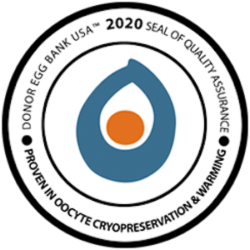
At Arizona Reproductive Medicine Specialists, we appreciate the difficult emotional and financial journey that you may have experienced leading you to consider our donor egg program.
For as low as $11,386 plus medications, our donor egg in vitro fertilization (IVF) package provides a comprehensive and simple solution for finding and using an egg donor, offering exceptional personal care, cost effective financial solutions and, most importantly, success.
We offer the some of the most innovative Egg Donor programs and (competitive pricing) in the nation.
Our Egg Donor Coordinator will work with you to find the best potential match for you and explain our programs.
We make finding an egg donor simple
You can start the process by either first searching for a donor from either our list of donors available for a fresh egg donation or our egg bank, “Donor Egg Bank USA.” Or, you can schedule a new-patient consultation with our physicians to review the entire process, answer your questions, and provide a personalized recommendation. Begin the process of searching for an egg donor by clicking on one of the links below. There is no cost or obligation to register.
Fresh versus frozen eggs
There are two approaches to egg donation treatment: Fresh egg donation and frozen egg donation using an egg bank. Each has distinct advantages and disadvantages. At Arizona Reproductive Medicine Specialists we excel in both approaches and are prepared to offer you the best in either option.
Fresh egg donation is where a donor is stimulated to produce eggs for a specific recipient or recipients. The recipient selects the donor and then the donor is stimulated. All of the eggs produced are available to the recipient or recipients matched to that donor.
Frozen egg donation is where donors are stimulated and the eggs are frozen and added to an egg bank. They are usually allocated into groups of eggs often called “lots.” The recipient choses a donor she likes and then purchases a cycle of treatment using a particular lot.
Fresh egg donation
This approach has been around for over 30 years and has proven itself to be very safe and very effective.
Advantages
- Largest number of eggs available to recipient. Most programs offer a “one-to-one” match, which means that one recipient is matched to one donor. This means that all of the eggs produced by one donor are available to the recipient. Some clinics offer “shared donations” where more than one recipient is matched to one donor. This approach lowers the cost of a cycle by splitting the donor costs between the recipients, but this is more difficult to coordinate and therefore can take longer to implement. A fresh one-to-one donation will usually create more embryos than any other alternative and therefore will give the recipient more chances to try per donation. It also offers a greater chance for more than one child from one donation, if that is desired.
- Highest success rate per transfer. This approach gives the highest success rate per transfer. This is probably because there are more eggs available to the recipient, meaning more embryos are generated. Because more embryos are generated, there is the opportunity to select the best embryo from many. This is what most likely increases the success rate per transfer of fresh egg donation.
- Highest success rate per allocation of eggs. Because more embryos are generated due to more eggs being allocated to the recipient, there are more embryo transfers available from one allocation of eggs. A frozen embryo transfer costs much less than the initial cost to obtain eggs and create the embryos.
- Lowest cost per embryo created. Because more embryos are created, the cost per embryo created is lower than in a cycle from an egg bank. The cost per blastocyst stage embryo created is about $3,000 whereas the cost per blastocyst stage embryo from an egg bank is about $5,000 to $7,000.
- Greatest years of experience. Because fresh egg donation has been around for over 30 years, the long-term safety of this procedure is more established.
Disadvantages
- Time. Depending on the availability of donors in general, and the availability of the donor you are ultimately matched with, it can take several months to be ready for your transfer if you do not immediately find a donor in the clinic’s list of available fresh donors. Once a donor is identified, it takes time to arrange the cycle around the donor’s schedule, depending on their availability.
- Cost. Because in most cases you will be offered a one to one match with a donor, all of the costs associated with that donor are born by the recipient. This therefor is the most expensive option. However, since there are many more embryos created than other options, the cost per embryo generated is usually the lowest.
Frozen egg donation with an egg bank
Advantages
- Speed. Eggs in an egg bank are already collected, frozen and held in a storage facility. In most cases, the time from reserving the eggs to embryo transfer can be as short as six weeks.
- Cost. A significant advantage of an egg bank is that the eggs from one donor are allocated into groups called “lots.” Each lot has six or more mature eggs. A donor usually supplies many eggs allocated into a number of lots, so the costs of that donation are divided amongst the recipients of those lots that are created in a single retrieval. The cost of the first embryo transfer is therefore usually several thousand dollars less than a one-to-one fresh egg donation. However, since more embryos are usually generated in a one-to-one fresh donation cycle, the cost per embryo generated is less with a fresh one-to-one donation.
- Selection. We are part of one of the largest egg banks in the United States and Canada. At any one time more that 250 donors are available for immediate selection. As a result, our recipients benefit from a wide and deep selection of most characteristics they are seeking in a donated egg.
Disadvantages
- Success rate. The success rate is good with a frozen egg bank. About 45 to 55 percent per transfer. Since there are fewer embryos available to select however, this rate is slightly lower than that achieved from a fresh egg donation.
- Cumulative success rate. Because fewer embryos are generated, there are fewer chances to try to get pregnant so the cumulative chance of having a pregnancy is lower.
- Number of eggs to start with. If a cycle with one lot is chosen , which is typically the case in order to get the lowest cost, then you are starting with a much lower number of eggs. As a result, you will have fewer embryos compared to a typical one to one fresh donor cycle.
- Cost per embryo created. Since you are starting with fewer eggs, fewer embryos are created. The cost per embryo generated is therefore higher in an egg banking cycle. The cost per blastocyst stage embryo created is about $3,000 for a fresh egg donation cycle whereas the cost per blastocyst stage embryo from an egg bank is about $5,000 to $7,000.
About our egg donor network (DEB USA)
 Largest Egg Bank in the USA with over 400 donors to choose from!
Largest Egg Bank in the USA with over 400 donors to choose from!
ARMS is a proud partner with Donor Egg Bank USA (DEB USA), one of the largest databases of culturally diverse donor eggs in the nation.
Donor Egg Bank USA is a network of some of the most respected and advanced fertility practices in the U.S. and Canada. In response to the growing need for a nationwide database of diverse egg donors, DEB USA was launched to assist patients in finding quality and ethnically diverse donor eggs. DEB USA also has the added convenience of a quicker process in selecting an egg donor and using the donated eggs in IVF treatment.
DEB USA only partners with fertility centers that have demonstrated good quality within the lab and a proficiency in egg freezing and thawing. Not all clinics can meet Donor Egg Bank USA’s high standards, and DEB USA tightly manages quality across the network to ensure very little variability between programs.
Frozen donor eggs for better egg donation experience
ARMS only works with Donor Egg Bank USA because we value the health and welfare of our egg donors. DEB USA has met our high quality standards.
Donor Egg Bank USA differs from most egg donor programs because all the eggs are frozen and ready to be shipped immediately. By using donor eggs that are already frozen, there is a 0 percent chance of a cancelled cycle due to a donor’s life event, failure to pass prescreening or issues with ovarian stimulation. Plus, additional eggs can be purchased for future children, upon completion of successful treatment.
Each available donor in the database has passed DEB USA’s initial screening, which includes baseline testing, infectious disease testing, psychological screening, drug screening, genetic testing, medical history review and a physical.
How frozen eggs from Deb USA were the solution to Jessica’s infertility
Assured refund guarantee
ARMS participates in DEB USA’s Assured Refund Plan. DEB USA is the only egg bank that offers a 100-percent money-back plan, including up to six egg lots (several eggs in a shipment) for transfer and unlimited frozen embryo transfer cycles.
More than 95 percent of applicants qualify for this plan. The Assured Refund Plan provides peace of mind throughout the process, all the way to baby’s delivery.
ARMS refund guarantee
ARMS also offers a similar refund plan for fresh egg donation cycles. We offer a 100 percent money-back plan, which includes three egg donation cycles from a donor including embryo biopsy for preimplantation genetic diagnosis and unlimited frozen embryo transfer cycles.